Nonsingular Phantom Cosmology in Five-Dimensional f(R, T) Gravity
Abstract
1. Introduction
2. Modified Einstein Field Equations
3. Solutions to the Field Equations
3.1.
3.2.
3.3.
4. Some Physical and Geometrical Properties
4.1. Status of the Model
4.2. Stability of the Model
4.3. EOS Parameter
5. Discussion and Conclusions
- (1)
- We notice that the model is free from the initial singularity and, hence, physically viable. This feature is obvious, as for , we obtain , and for , one can obtain .
- (2)
- The cosmic distribution has a finite fluid pressure and matter density at . The physical quantities decrease as increases and tend to zero when . Thus, our presented model leads to a vacuum cosmological solution at infinite time.
- (3)
- As , so the model is anisotropic throughout the evolution. Again, exhibits the expanding universe. However, dictates that the universe is decelerating.
- (4)
- The stability of the model is obtained by considering the ratio , which is positive for , to yield a stable model.
- (5)
- The EOS parameter is governed by the parameter , and its value can be found as . This is related to , which behaves like a phantom-energy-inspired cosmology. This type of phantom cosmology allows us to account for the dynamics and matter content of the universe, tracing back the evolution to the inflationary epoch [74]. In this connection, we would also like to point out that while the dependence of is explicit across all cases, this is not overall true, as this situation is solely visible in the results from Case 3.1. One can note that Case 3.3 shows a clear time dependence (and therefore, very dependent on the magnitude of ).
- (6)
- The anisotropic/isotropic behavior of the models for different choices of the parameters are given in Table 1 in connection with Case 3.2.
Author Contributions
Funding
Data Availability Statement
Acknowledgments
Conflicts of Interest
References
- Minkowski, H. Die Grundgleichungen für die Elektromagnetischen Vorgänge in bewegten Körpern. Wissenschaften zu Göttingen, Mathematisch-Physikalische 1908, 1908, 53–111. [Google Scholar]
- Minkowski, H. Jahresbericht der Deutschen Mathematiker-Vereinigung. Raum und Zeit 1909, 18, 75–88. [Google Scholar]
- Landau, L.D.; Lifshitz, E.M. The Classical Theory of Fields. Course of Theoretical Physics, 4th ed.; Butterworth-Heinemann: Oxford, UK, 2002; Volume 2. [Google Scholar]
- Kaluza, T. Zum Unitätsproblem in der Physik. Sitz. Preuss. Akad Wiss. 1921, 33, 966–972. [Google Scholar]
- Klein, O. Quantentheorie und fünfdimensionale Relativitätstheorie. Z. Phys. 1926, 37, 895–906. [Google Scholar] [CrossRef]
- Chodos, A.; Detweiler, S. Where has the fifth dimension gone? Phys. Rev. D 1980, 21, 2167–2170. [Google Scholar] [CrossRef]
- Alvarez, E.; Gavela, M.B. Entropy from Extra Dimensions. Phys. Rev. Lett. 1983, 51, 931–934. [Google Scholar] [CrossRef]
- Marciano, W.J. Time Variation of the Fundamental “Constants" and Kaluza–Klein Theories. Phys. Rev. Lett. 1984, 52, 489–491. [Google Scholar] [CrossRef]
- Gegenberg, J.D.; Das, A. Five-dimensional cosmological models with massless scalar fields. Phys. Lett. 1985, 112A, 427–430. [Google Scholar] [CrossRef]
- Lorenz-Petzold, D. Higher-dimensional extensions of Bianchi type-I cosmologies. Phys. Rev. 1985, 31, 929–931. [Google Scholar] [CrossRef]
- Wesson, P.S. Astrophysical data and cosmological solutions of a Kaluza–Klein theory of gravity. Astron. Astrophys. 1986, 166, 1–3. [Google Scholar]
- Grøn, Ø. Inflationary cosmology according to Wesson’s gravitational theory. Astron. Astrophys. 1988, 193, 1–4. [Google Scholar]
- Wesson, P. 5-Dimensional Physics: Classical and Quantum Consequences of Kaluza Klein Cosmology; World Scientific Publishing Company: Singapore, 2006. [Google Scholar]
- Abbott, R.B.; Barr, S.M.; Ellis, S.D. Kaluza-Klein cosmologies and inflation. Phys. Rev. D 1984, 30, 720–727. [Google Scholar] [CrossRef]
- Sahdev, D. Towards a realistic Kaluza-Klein cosmology. Phys. Lett. 1984, 137B, 155–159. [Google Scholar] [CrossRef]
- Chatterjee, S.; Bhui, B. Homogeneous cosmological model in higher dimension. Mon. Not. R. Astron. Soc. 1990, 247, 57–61. [Google Scholar]
- Bergamini, R.; Orzalesi, C. Towards a cosmology for multidimensional unified theories. Phys. Lett. B 1984, 135, 38–42. [Google Scholar] [CrossRef]
- Ishihara, H. Kaluza-Klein Inflation. Prog. Theor. Phys. 1984, 72, 376–378. [Google Scholar] [CrossRef][Green Version]
- Banerjee, A.; Bhui, B.; Chatterjee, S. Bianchi type I cosmological models in higher dimensions. Astrophys. J. 1990, 358, 23–27. [Google Scholar] [CrossRef]
- Chatterjee, S.; Bhui, B.; Basu, M.B.; Banerjee, A. Inhomogeneous model with a cosmological constant. Phys. Rev. D 1994, 50, 2924–2927. [Google Scholar] [CrossRef]
- Banerjee, A.; Panigrahi, D.; Chatterjee, S. A class of inhomogeneous cosmological models in Kaluza–Klein spacetime. Class. Quantum Gravit. 1994, 11, 1405–1414. [Google Scholar] [CrossRef]
- Banerjee, A.; Das, A.; Panigrahi, D. Singularity-free cylindrically symmetric solutions in Kaluza-Klein space-time. Phys. Rev. D 1995, 51, 6816–6820. [Google Scholar] [CrossRef]
- Ledesma, D.S.; Bellini, M. Single field inflationary models with non-compact Kaluza–Klein theory. Phys. Lett. B 2004, 581, 1–8. [Google Scholar] [CrossRef]
- Aguilar, J.E.M.; Bellini, M. Noncompact Kaluza–Klein theory and inflationary cosmology: A complete formalism. Phys. Lett. B 2004, 596, 116–122. [Google Scholar] [CrossRef][Green Version]
- Bellini, M. Inflationary cosmology from STM theory of gravity. Nucl. Phys. B 2003, 660, 389–400. [Google Scholar] [CrossRef]
- Liko, T.; Wesson, P.S. An exact solution of the five-dimensional Einstein equations with four-dimensional de Sitter-like expansion. J. Math. Phys. 2005, 46, 062504. [Google Scholar] [CrossRef]
- Mukhopadhyay, U.; Ghosh, P.P.; Ray, S. Higher dimensional dark energy investigation with variable Λ and G. Int. J. Theor. Phys. 2010, 49, 1622–1627. [Google Scholar] [CrossRef][Green Version]
- Sharif, M.; Khanum, F. Kaluza-Klein cosmology with varying G and Λ. Astrophys. Space Sci. 2011, 334, 209–214. [Google Scholar] [CrossRef][Green Version]
- Pahwa, I. Higher dimensional cosmological models: An alternative explanation for late time cosmic acceleration. J. Phys. Conf. Ser. 2014, 484, 012045. [Google Scholar] [CrossRef]
- Perlmutter, S.; Aldering, G.; Della Valle, M.; Deustua, S.; Ellis, R.S.; Fabbro, S.; Fruchter, A.; Goldhaber, G.; Groom, D.E.; Hook, I.M.; et al. Discovery of a supernova explosion at half the age of the Universe. Nature 1998, 391, 51–54. [Google Scholar] [CrossRef]
- Perlmutter, S.; Aldering, G.; Goldhaber, G.; Knop, R.A.; Nugent, P.; Castro, P.G.; Deustua, S.; Fabbro, S.; Goobar, A.; Groom, D.E.; et al. Measurements of Ω and Λ from 42 high-redshift supernovae. Astrophys. J. 1999, 517, 565–586. [Google Scholar] [CrossRef]
- Knop, R.A.; Aldering, G.; Amanullah, R.; Astier, P.; Blanc, G.; Burns, M.S.; Conley, A.; Deustua, S.E.; Doi, M.; Ellis, R.; et al. New constraints on ΩM, ΩΛ, and w from an independent set of 11 high-redshift supernovae observed with the Hubble Space Telescope. Astrophys. J. 2003, 598, 102–137. [Google Scholar] [CrossRef]
- Riess, A.G.; Filippenko, A.V.; Challis, P.; Clocchiatti, A.; Diercks, A.; Garnavich, P.M.; Gilliland, R.L.; Hogan, C.J.; Jha, S.; Kirshner, R.P.; et al. Observational evidence from supernovae for an accelerating Universe and a cosmological constant. Astron. J. 1998, 116, 1009–1038. [Google Scholar] [CrossRef]
- Riess, A.G.; Strolger, L.-G.; Tonry, J.; Casertano, S.; Ferguson, H.C.; Mobasher, B.; Challis, P.; Filippenko, A.V.; Jha, S.; Li, W.; et al. Type Ia supernova discoveries at z > 1 from the Hubble Space Telescope: Evidence for past deceleration and constraints on dark energy evolution. Astron. J. 2004, 607, 665–687. [Google Scholar] [CrossRef]
- Tonry, J.L.; Schmidt, B.P.; Barris, B.; Candia, P.; Challis, P.; Clocchiatti, A.; Coil, A.L.; Filippenko, A.V.; Garnavich, P.; Hogan, C.; et al. Cosmological results from high-z supernovae. Astron. J. 2003, 594, 1–24. [Google Scholar] [CrossRef]
- Valentino, E.D.; Mena, O.; Pan, S.; Visinelli, L.; Yang, W.; Melchiorri, A.; Mota, D.F.; Riess, A.G.; Silk, J. In the realm of the Hubble tension—a review of solutions. Class. Quantum Grav. 2021, 38, 153001. [Google Scholar] [CrossRef]
- Valentino, E.D. Challenges of the standard cosmological model. Universe 2022, 8, 399. [Google Scholar] [CrossRef]
- Harko, T.; Lobo, F.S.N.; Nojiri, S.; Odintsov, S.D. f(R, T) gravity. Phys. Rev. D 2011, 84, 024020. [Google Scholar] [CrossRef]
- Capozziello, S.; Laurentis, M.D. Extended theories of gravity. Phys. Rep. 2011, 509, 167–321. [Google Scholar] [CrossRef]
- Adhav, K.S. LRS Bianchi type-I cosmological model in f(R, T) theory of gravity. Astrophys. Space Sci. 2012, 339, 365–369. [Google Scholar] [CrossRef]
- Alvarenga, F.G.; Houndjo, M.J.S.; Monwanou, A.V.; Orou, J.B.C. Testing some f(R, T) gravity models from energy conditions. J. Mod. Phys. 2013, 4, 130–139. [Google Scholar] [CrossRef]
- Mahanta, K.L. Bulk viscous cosmological models in f(R, T) theory of gravity. Astrophys. Space Sci. 2014, 353, 683–689. [Google Scholar] [CrossRef]
- Mishra, B.; Sahoo, P.K. Bianchi type VIh perfect fluid cosmological model in f(R, T) theory. Astrophys Space Sci. 2014, 352, 331–336. [Google Scholar] [CrossRef]
- Cai, Y.-F.; Capozziello, S.; Laurentis, M.D.; Saridakis, E.N. f(T) teleparallel gravity and cosmology. Rept. Prog. Phys. 2016, 79, 106901. [Google Scholar] [CrossRef] [PubMed]
- Das, A.; Rahaman, F.; Guha, B.K.; Ray, S. Compact stars in f(R, T) gravity. Eur. Phys. J. C 2016, 76, 654. [Google Scholar] [CrossRef]
- Das, A.; Ghosh, S.; Guha, B.K.; Das, S.; Rahaman, F.; Ray, S. Gravastars in f(R, T) gravity. Phys. Rev. D 2017, 95, 124011. [Google Scholar] [CrossRef]
- Moraes, P.H.R.S.; Sahoo, P.K. Modeling wormholes in f(R, T) gravity. Phy. Rev. D 2018, 97, 024007. [Google Scholar] [CrossRef]
- Mishra, B.; Tripathy, S.K.; Tarai, S. Cosmological models with a hybrid scale factor in an extended gravity theory. Mod. Phys. Lett. A 2018, 33, 1850052. [Google Scholar] [CrossRef]
- Deb, D.; Guha, B.K.; Rahaman, F.; Ray, S. Anisotropic strange stars under simplest minimal matter-geometry coupling in the f(R, T) gravity. Phys. Rev. D 2018, 97, 084026. [Google Scholar] [CrossRef]
- Deb, D.; Rahaman, F.; Ray, S.; Guha, B.K. Strange stars in f(R, T) gravity. J. Cosmol. Astropart. Phys. 2018, 03, 044. [Google Scholar] [CrossRef]
- Biswas, S.; Ghosh, S.; Guha, B.K.; Rahaman, F.; Ray, S. Strange stars in Krori–Barua spacetime under f(R, T) gravity. Ann. Phys. 2019, 401, 1–20. [Google Scholar] [CrossRef]
- Deb, D.; Ketov, S.V.; Khlopov, M.; Ray, S. Study on charged strange stars in f(R, T) gravity. J. Cosmol. Astropart. Phys. 2019, 10, 070. [Google Scholar] [CrossRef]
- Deb, D.; Ketov, S.V.; Maurya, S.K.; Khlopov, M.; Moraes, P.H.R.S.; Ray, S. Exploring physical features of anisotropic strange stars beyond standard maximum mass limit in f(R, T) gravity. Mon. Not. R. Astron. Soc. 2019, 485, 5652–5665. [Google Scholar] [CrossRef]
- Fisher, S.B.; Carlson, E.D. Reexamining f(R, T) gravity. Phys. Rev. D 2019, 100, 064059. [Google Scholar] [CrossRef]
- Biswas, S.; Shee, D.; Ray, S.; Guha, B.K. Anisotropic strange star with Tolman–Kuchowicz metric under f(R, T) gravity. Eur. Phys. J. C 2020, 80, 175. [Google Scholar] [CrossRef]
- Ray, S.; Sengupta, R.; Nimesh, H. Gravastar: An alternative to black hole. Int. J. Mod. Phys. D 2020, 29, 2030004. [Google Scholar] [CrossRef]
- Hulke, N.; Singh, G.P.; Bishi, B.K.; Singh, A. Variable Chaplygin gas cosmologies in f(R, T) gravity with particle creation. New Astron. 2020, 77, 101357. [Google Scholar] [CrossRef]
- Mishra, B.; Esmeili, F.M.; Ray, S. Cosmological models with variable anisotropic parameter in f(R, T) gravity. Ind. J. Phys. 2021, 95, 2245–2254. [Google Scholar] [CrossRef]
- Varshney, G.; Sharma, U.K.; Pradhan, A.; Kumar, N. Reconstruction of Tachyon, Dirac-Born-Infeld-essence and Phantom model for Tsallis holographic dark energy in f(R, T) gravity. Chin. J. Phys. 2021, 73, 56–73. [Google Scholar] [CrossRef]
- Pradhan, A.; Garg, P.; Dixit, A. FRW cosmological models with cosmological constant in f(R, T) theory of gravity. Can. J. Phys. 2021, 99, 741–753. [Google Scholar] [CrossRef]
- Bhardwaj, V.K.; Pradhan, A. Evaluation of cosmological models in gravity in different dark energy scenario. New Astron. 2022, 91, 101675. [Google Scholar] [CrossRef]
- Tiwari, R.K.; Beesham, A.; Mishra, S.; Dubey, V. Bianchi type I cosmological model in f(R, T) gravity. Phys. Sci. Forum 2021, 2, 38. [Google Scholar] [CrossRef]
- Tiwari, R.K.; Beesham, A.; Mishra, S.; Dubey, V. Anisotropic cosmological model in a modified theory of gravitation. Universe 2021, 7, 226. [Google Scholar] [CrossRef]
- Bertolami, O.; Lobo, F.S.N.; Paramos, J. Nonminimal coupling of perfect fluids to curvature. Phys. Rev. D 2008, 78, 064036. [Google Scholar] [CrossRef]
- Schutz, B.F. Perfect fluids in general relativity: Velocity potentials and a variational principle. Phys. Rev. D 1970, 2, 2762. [Google Scholar] [CrossRef]
- Brown, J.D. Action functionals for relativistic perfect fluids. Class. Quantum Gravit. 1993, 10, 1579. [Google Scholar] [CrossRef]
- Baffou, E.H.; Houndjo, M.J.S.; Rodrigues, M.E.; Kpadonou, A.V.; Tossa, J. Cosmological evolution in f(R, T) theory with collisional matter. Phys. Rev. D 2015, 92, 084043. [Google Scholar] [CrossRef]
- Mohanty, G.; Sahoo, R.R. Mesonic stiff fluid distribution in five dimensional Bianchi type space time. Astrophys. Space Sci. 2008, 314, 1–6. [Google Scholar] [CrossRef]
- Collins, C.B.; Glass, E.N.; Wilkinson, D.A. Exact spatially homogeneous cosmologies. Gen. Relativ. Gravit. 1980, 12, 805–823. [Google Scholar] [CrossRef]
- Moraes, P.H.R.S. Cosmology from induced matter model applied to 5D f(R, T) theory. Astrophys. Space Sci. 2014, 352, 273–279. [Google Scholar] [CrossRef]
- Borkar, M.S.; Ameen, A. Evaluation of Bianchi type VI0 magnetized anisotropic dark energy models with constant deceleration parameter in bimetric theory of gravitation. Int. J. Mod. Phys. D 2015, 24, 1550019. [Google Scholar] [CrossRef]
- Caldwell, R.R. A phantom menace? Cosmological consequences of a dark energy component with super-negative equation of state. Phys. Lett. B 2002, 545, 23–29. [Google Scholar] [CrossRef]
- Caldwell, R.R.; Kamionkowski, M.; Weinberg, N.N. Phantom energy: Dark energy with w < −1 causes a cosmic doomsday. Phys. Rev. Lett. 2003, 91, 071301. [Google Scholar] [CrossRef] [PubMed]
- Capozziello, S.; Nojiri, S.; Odintsov, S.D. Unified phantom cosmology: Inflation, dark energy and dark matter under the same standard. Phys. Lett. B 2006, 632, 597–604. [Google Scholar] [CrossRef]
- Astashenok, A.V.; Nojiri, S.; Odintsov, S.D.; Yurov, A.V. Phantom cosmology without Big Rip singularity. Phys. Lett. B 2012, 709, 396–403. [Google Scholar] [CrossRef]
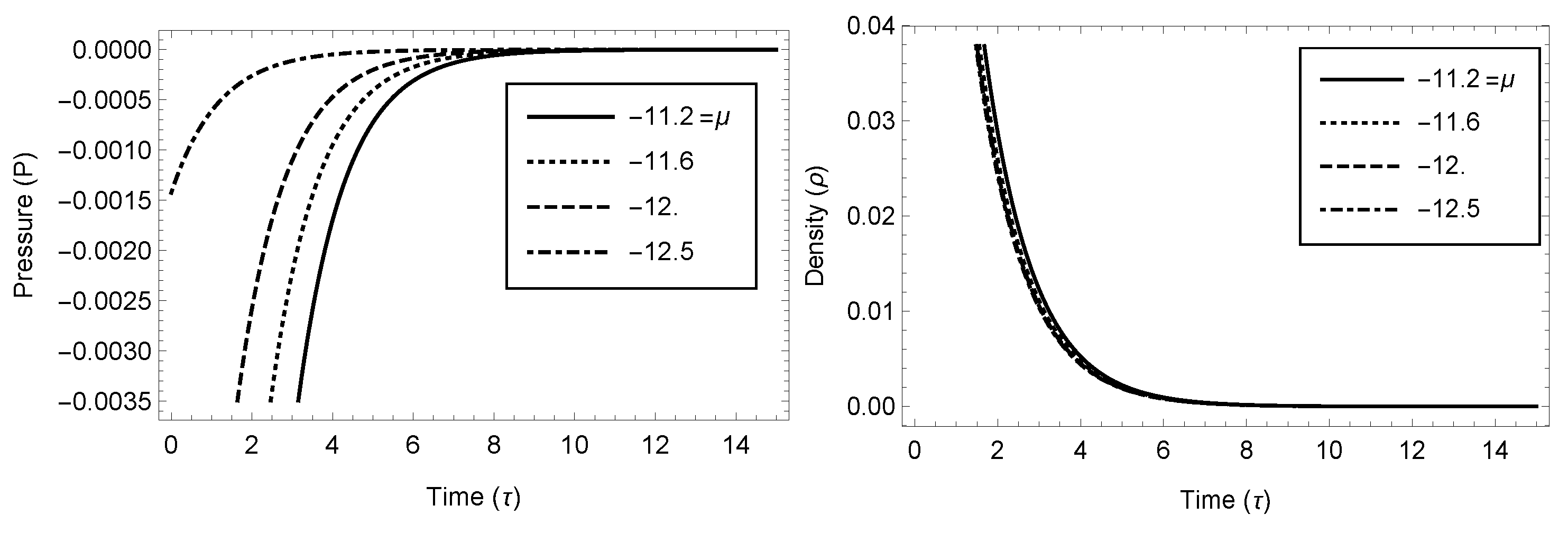
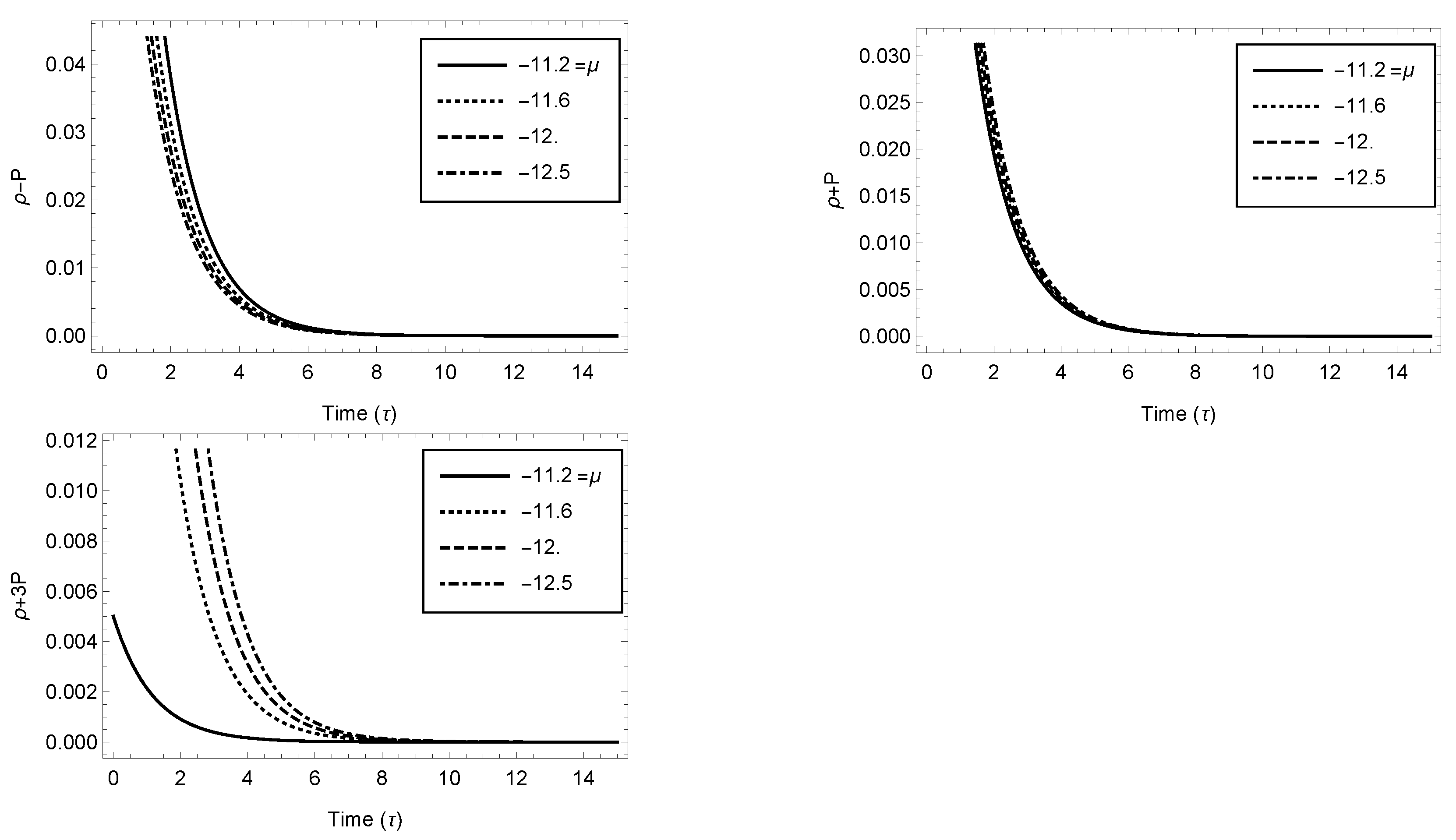

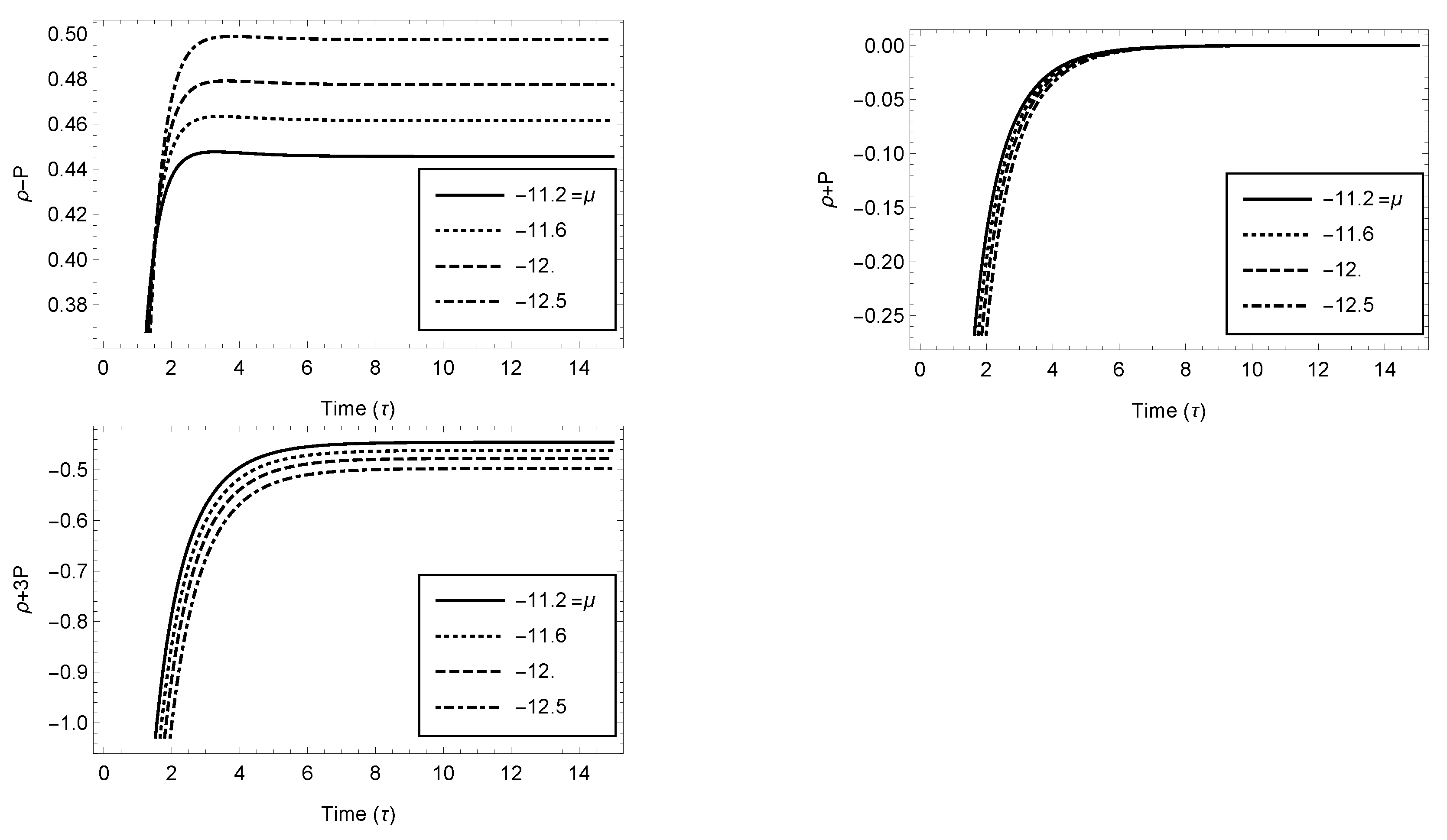
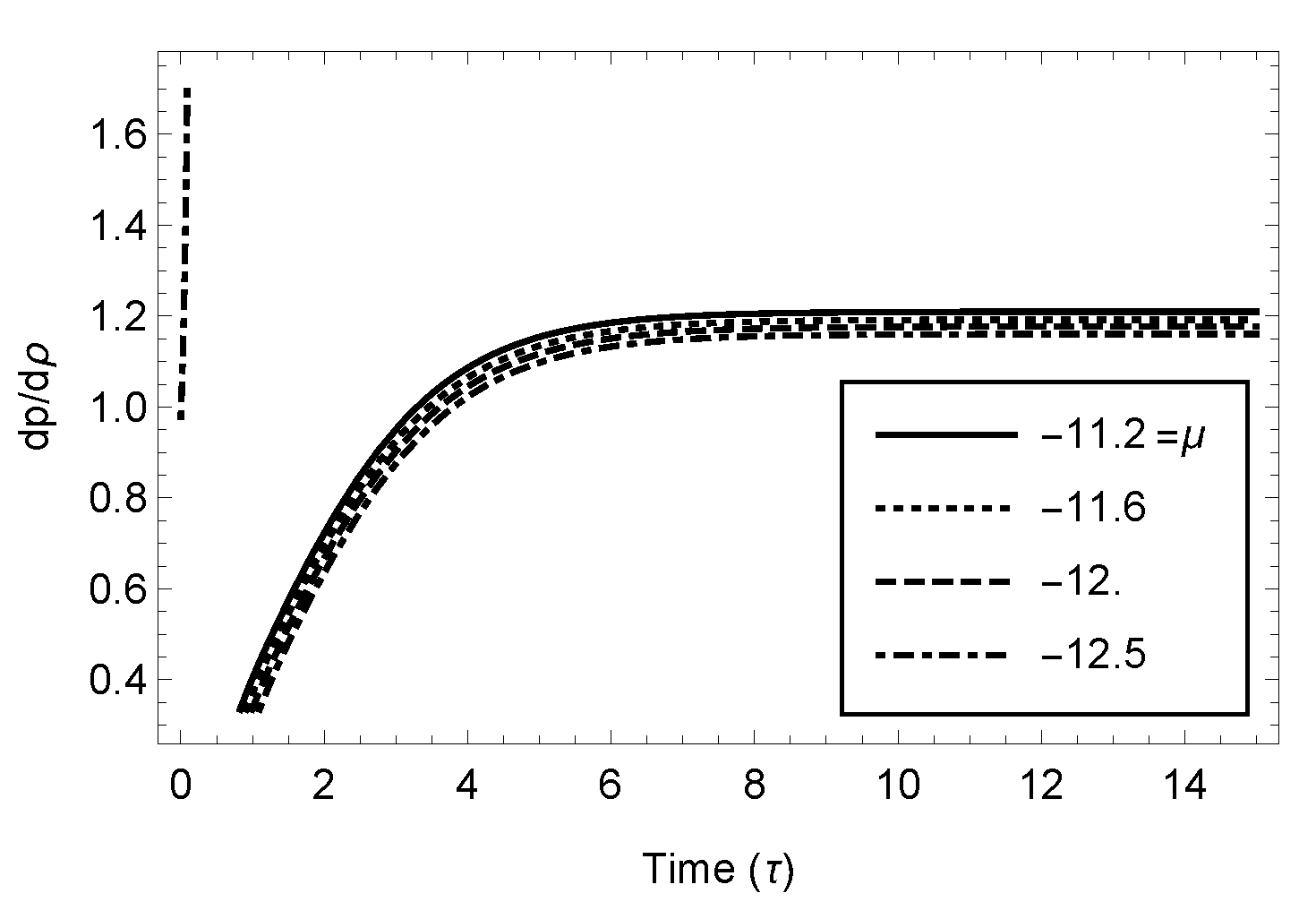
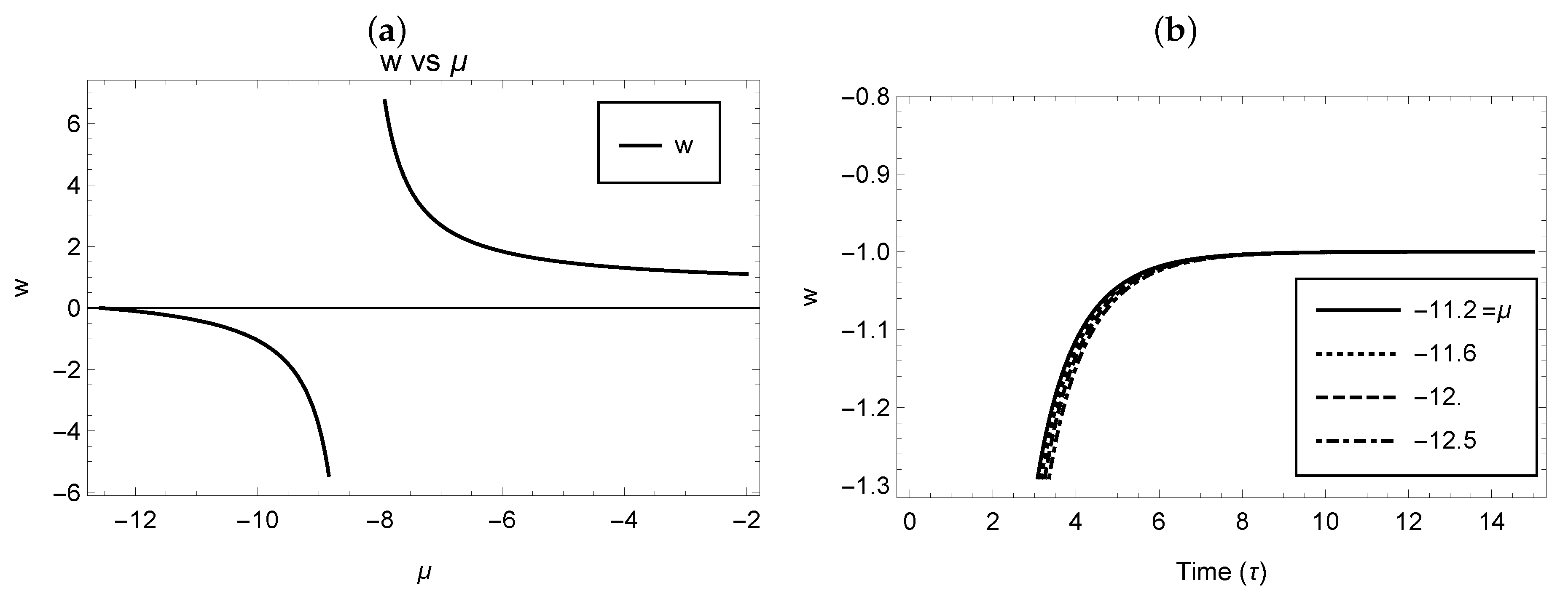
| For Case 3.2 | , | , | , | , |
|---|---|---|---|---|
| V | expanding | expanding | decreasing | constant |
| decreasing | decreasing | negative | 0 | |
| q | 3 | 3 | 3 | undefined |
| z | decreasing | decreasing | increasing | 0 |
| 0 | undefined |
Publisher’s Note: MDPI stays neutral with regard to jurisdictional claims in published maps and institutional affiliations. |
© 2022 by the authors. Licensee MDPI, Basel, Switzerland. This article is an open access article distributed under the terms and conditions of the Creative Commons Attribution (CC BY) license (https://creativecommons.org/licenses/by/4.0/).
Share and Cite
Sahoo, R.R.; Mahanta, K.L.; Ray, S. Nonsingular Phantom Cosmology in Five-Dimensional f(R, T) Gravity. Universe 2022, 8, 573. https://doi.org/10.3390/universe8110573
Sahoo RR, Mahanta KL, Ray S. Nonsingular Phantom Cosmology in Five-Dimensional f(R, T) Gravity. Universe. 2022; 8(11):573. https://doi.org/10.3390/universe8110573
Chicago/Turabian StyleSahoo, Rakesh Ranjan, Kamal Lochan Mahanta, and Saibal Ray. 2022. "Nonsingular Phantom Cosmology in Five-Dimensional f(R, T) Gravity" Universe 8, no. 11: 573. https://doi.org/10.3390/universe8110573
APA StyleSahoo, R. R., Mahanta, K. L., & Ray, S. (2022). Nonsingular Phantom Cosmology in Five-Dimensional f(R, T) Gravity. Universe, 8(11), 573. https://doi.org/10.3390/universe8110573








